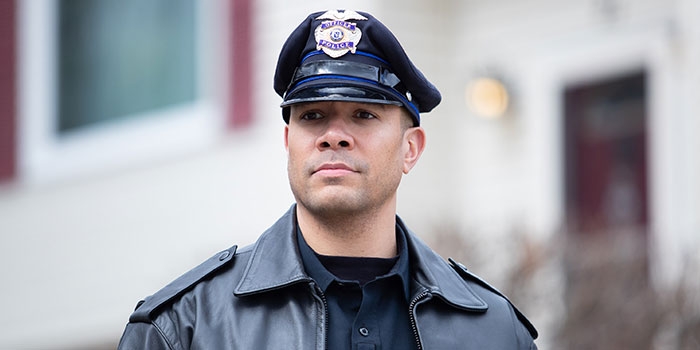The Pandemic's Effect on the Opioid Epidemic
- News & Events
- News
- The Pandemic's Effect on the Opioid Epidemic

While COVID-19 takes hundreds of lives each day, RIC alumnus and Cranston Police Officer Joshua Brown is busy saving lives from death by overdose.
So much attention has been given to COVID-19 that we may have lost sight of the opioid epidemic that has also been engulfing the country.
On an average day, 130 people die of an opioid-related overdose, reported the Center for Disease Control – this is unprecedented in American history – and Rhode Island ranks among the top 10 states with the highest fatalities.
"Our department responds to two to three drug overdoses a day," says Joshua Brown, a RIC alumnus and patrolman for the Cranston Police Department. "On my own tours, which is every four days, I encounter between one and two overdoses per tour. But when COVID-19 arrived, overdose calls on the radio stopped."
That's like freezing the frame on a surging tsunami.
Back in 2013, when Brown graduated from Rhode Island College with a communication degree and entered the Police Academy three months later, the third wave of the opioid crisis had hit. The first wave was marked by an increase in overdose deaths from prescription painkillers, the second wave was marked by overdose deaths from heroin and the third wave was marked by overdose deaths involving illicitly manufactured fentanyl.
Fentanyl is notably one of the strongest opioids on the market (100 times more potent than morphine and 50 times more potent than heroin). It is sold through illegal drug markets and is often mixed with heroin, counterfeit pills or cocaine as a combination product – with or without the user's knowledge – to increase its euphoric effects.
Since 2013 the rate of drug overdoses involving fentanyl increased by more than 100 percent each year. In fact experts say the opioid crisis has become a fentanyl crisis.
Law enforcement agencies across the country responded by training and equipping police officers to prevent fatalities using Narcan® [also known as naloxone]. Available as an injection or a nasal spray, Narcan® blocks or reverses the effects of opioids. Anyone can purchase Narcan® over the counter and apply it, but it isn't guaranteed to prevent fatalities, particularly if the individual OD'ed on a drug laced with fentanyl.
"I got a call that an individual had passed out on the ground," Brown says. "When people found him, he had the Narcan® shot in his pocket. They administered the shot, but he didn’t respond. I gave him the 5 mg. nasal spray, which is much stronger, along with chest rubs and he came to. Without the additional 5 mg., he would have died. When a drug has been laced with fentanyl, it's particularly difficult to bring them back."

"Both paramedics and police are called when there’s an overdose, but usually the police are the first on the scene," he says. "On another call I was told that an unresponsive male, who had been on heroin laced with fentanyl for days, was unconscious in a basement apartment. The place was in disarray, there was urine on the floor, needles everywhere. It appeared that he had died on the couch but actually he was in a drug-induced coma. He had been there so long that an infection had started to eat away at the skin on his hips. The paramedics would later have to cut away the fabric from his skin."
Brown administered 5 mg. of Narcan® nasal spray, but even that wasn't enough to revive the young man. When the paramedics arrived, they administered another 1.5 to 2 mg. injection. It took multiple additional doses to bring him back.
"I've responded to overdose calls at this address before, which isn't uncommon," Brown says. "Often we find the same individuals are overdosing again and again. I think Narcan® can be a double-edged sword. While it saves lives because a person can carry it with them and anyone can administer it, some may be losing sight of the true danger of overdosing."
Fentanyl also poses a significant danger to Brown and other first responders who may unwittingly come in contact with it either by absorbing it through the skin or accidentally inhaling airborne powder. The effects of exposure are rapid and profound. Symptoms may include disorientation, sedation and cardiac arrest within seconds.
"We've had officers who were exposed who had to be rushed to emergency," he says. "As a safety precaution, we wear gloves, and instead of testing drug samples at the scene, they're put in an evidence bag and transported to the station for testing in a lab."
Although overdose calls declined at the onset of COVID-19, the numbers surged again by the summer. "The opioid epidemic hasn't gone away," says Brown. "In fact, the cost of heroin on the streets is going down, giving users greater access. Our job is to try to keep the drugs off the street." And to save lives.
On each tour, Brown pulls yet another individual back from the brink of death in the line of duty, potentially exposing himself to fentanyl and to COVID. Although federal and state data on fatal and nonfatal overdoses since COVID are not yet available, what Brown is sure of is that as long as illegal opioids are on the streets, Rhode Island and the nation will continue to grapple with the opioid crisis long after COVID is gone.
